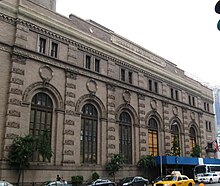|
New York City steam system
  The New York City steam system includes Con Edison's Steam Operations, which provides steam to large parts of Manhattan. Other smaller systems provide steam to New York University and Columbia University, and many individual buildings in New York City also have their own steam systems. The steam is used to heat and cool buildings and for cleaning and disinfecting. It is the largest such system in the world and has been in operation since 1882. Con Edison's Steam OperationsCon Edison's Steam Operations is a district heating system which carries steam from generating stations under the streets to heat and cool buildings and businesses in Manhattan. Some New York City businesses and facilities also use steam for cleaning and disinfection.[1] The New York Steam Company began providing service in lower Manhattan on March 3, 1882.[2] The company merged with Consolidated Edison on March 8, 1954.[2][3] Today, Con Edison operates the largest commercial steam system in the world (larger than the next nine combined).[4] The organization within Con Edison responsible for the system's operation, known as Steam Operations, provides steam service to over 1,700 commercial and residential customers in Manhattan from Battery Park to 96th Street uptown on the west side, and 89th Street on the east side of Manhattan. Roughly 27 billion pounds (12,000,000 t) of steam flow through the system every year.[5] The steam is produced at four plants in Manhattan and one each in Brooklyn and Queens; the primary plant is between 14th and 15th streets on Manhattan's east side. These plants boil water from the New York City water supply system, making Con Edison one of the largest users of the municipal water supply system.[1] Steam vapor can be caused by a leak in Con Ed's steam system or by cooler water contacting the outside of a steam pipe.[6] The vapor is often vented out through 10-foot (3.0 m) orange-and-white funnels in the street, known as stacks. Over the years, the stacks have been depicted in numerous TV shows and films.[1] UsesSteam provides heat and cooling to many buildings in New York. The steam system also provides humidity to art museums, steam cleaning for restaurants to clean dishes, and other uses.[4] Environmental effectsApproximately 30% of the ConEd steam system's installed capacity and 50% of the annual steam generated comes from cogeneration.[7] Cogeneration and Heat Recovery Steam Generation (HRSG) significantly increase the fuel efficiency of cogenerated electricity and thereby reduce the emission of pollutants, such as NOx, sulfur dioxide, carbon dioxide, and particulate matter, as well as the city's carbon footprint. Con Edison is promoting the use of steam for cooling in the summer months, something that can be accomplished with the installation of absorption chillers.[8] Such trigeneration systems reduce peak electrical loads and save construction costs associated with expanding electrical infrastructure. Clouds of condensation are vented from manholes in Manhattan through orange and white "chimneys". This can be caused by external water being boiled by contact with the steam pipes or by leaks in the steam system itself.[6] At least twelve steam pipe explosions have occurred in New York City since 1987.[9] The most recent major incident was the 2018 steam pipe explosion which occurred in the Flatiron District and forced the evacuation of 49 buildings.[10][11] The explosion released concrete, asphalt, "asbestos-containing material" and mud into the air. The asbestos was cleaned out of the air to a safe level.[12][13] A previous incident was the 2007 New York City steam explosion, and another on June 28, 1996, at a plant on East 74th Street.[14] A person was also killed by steam in the underground system after falling through a manhole in 2002.[15] The incident was later covered on the show NYPD 24/7.[16] Plants  There are six plants:[1]
See also
References
External links |